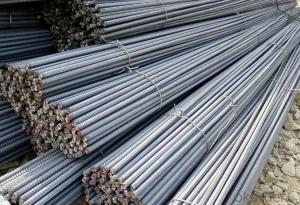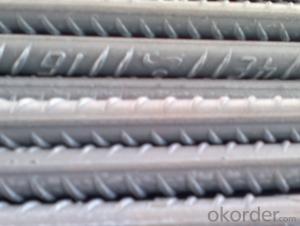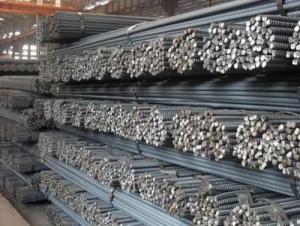Hot Rolled Deformed Steel Rebar
- Loading Port:
- China Main Port
- Payment Terms:
- TT or LC
- Min Order Qty:
- 25MT m.t.
- Supply Capability:
- 800000TONS/YEAR m.t./month
OKorder Service Pledge
OKorder Financial Service
You Might Also Like
Specifications of Hot Rolled Deformed Steel Rebar:
Standard | GB UK USA | HRB335 HRB400 HRB500 G460B, B500A, B500B,B500C GR40, GR60 | |
Diameter | 6mm,8mm,10mm,12mm,14mm,16mm,18mm,20mm, 22mm,25mm,28mm,32mm,36mm,40mm,50mm | ||
Length | 6M, 9M,12M or as required | ||
Payment term | TT or L/C | ||
Trade terms | FOB, CFR, CIF | ||
Application | Building, construction | ||
Each bundle weight | 2-3MT, or as required | ||
Type | Hot rolled steel rebar | ||
Brand name | DRAGON | ||
Theoretical weight and section area of each diameter as below for your information:
Diameter(mm) | Section area (mm²) | Mass(kg/m) | Weight of 12m (kg) | Pcs/ton |
6 | 28.27 | 0.222 | 2.664 | 375.38 |
8 | 50.27 | 0.395 | 4.74 | 210.97 |
10 | 78.54 | 0.617 | 7.404 | 135.06 |
12 | 113.1 | 0.888 | 10.656 | 93.84 |
14 | 153.9 | 1.21 | 14.52 | 68.87 |
16 | 201.1 | 1.58 | 18.96 | 52.74 |
18 | 254.5 | 2.00 | 24 | 41.67 |
20 | 314.2 | 2.47 | 29.64 | 33.74 |
22 | 380.1 | 2.98 | 35.76 | 27.96 |
25 | 490.9 | 3.85 | 46.2 | 21.65 |
28 | 615.8 | 4.83 | 57.96 | 17.25 |
32 | 804.2 | 6.31 | 75.72 | 13.21 |
36 | 1018 | 7.99 | 98.88 | 10.43 |
40 | 1257 | 9.87 | 118.44 | 8.44 |
50 | 1964 | 15.42 | 185.04 | 5.40 |
Deformed Steel Rebar in warehouse
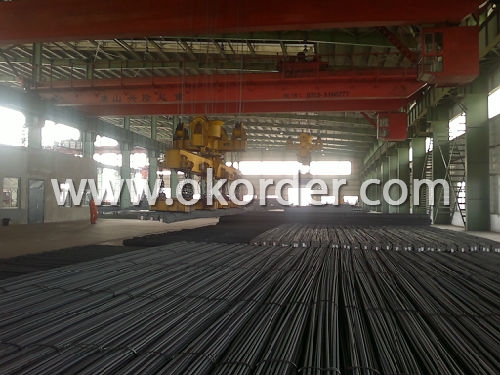
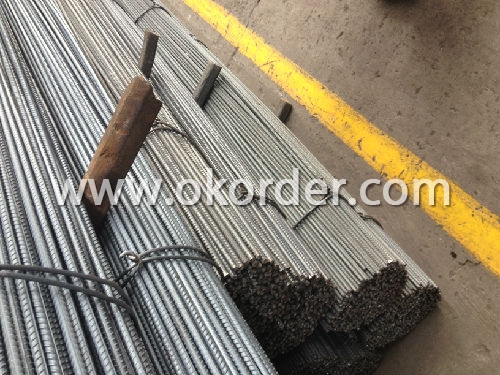
Usage and Applications of Hot Rolled Deformed Steel Rebar:
Deformed bar is widely used in buildings, bridges, roads and other engineering construction. Big to highways, railways, bridges, culverts, tunnels, public facilities such as flood control, dam, small to housing construction, beam, column, wall and the foundation of the plate, deformed bar is an integral structure material. With the development of world economy and the vigorous development of infrastructure construction, real estate, the demand for deformed bar will be larger and larger..
Packaging & Delivery of Hot Rolled Deformed Steel Rebar:
Packaging Detail: products are packed in bundle and then shipped by container or bulk vessel, deformed bar is usually naked strapping delivery, when storing, please pay attention to moisture proof. The performance of rust will produce adverse effect.
Delivery Detail: within 45 days after received advanced payment or LC.
Label: to be specified by customer, generally, each bundle has 1-2 labels
Note:
1. Our products are produced according to national standard (GB), if not, supply according to national standards (GB) or agreement as customer required.
2. Other Grade and Standard Deformed Steel Bar we can supply:
Grade: GR40/GR60, G460B/B500A/B500B/B500C,BST500S
Standard: ASTM, BS, DIN
The Minimum Order Quantity of these products is high, and need to be confirmed.
3. We can not only supply Deformed Steel Bar; if you need anything about building materials, please contact us for further information.
4. Please send us your detail specifications when inquire. We will reply to you as soon as possible. We sincerely hope we can establish a long stable business relationship.
- Q:What is the weight of a typical steel rebar?
- The weight of a typical steel rebar can vary depending on its size and length. On average, a 1-inch diameter, 20-foot long steel rebar weighs around 13.6 pounds.
- Q:What is the role of steel rebars in preventing shrinkage cracks in concrete?
- The prevention of shrinkage cracks in concrete is greatly aided by the use of steel rebars. These cracks occur naturally during the drying and curing process of concrete, as the water content evaporates and the material contracts. This contraction can weaken the concrete's structural integrity and durability. The addition of steel rebars to concrete helps counteract shrinkage cracks by providing tensile strength. Concrete is strong when compressed, but weak when subjected to tension. As the concrete shrinks during drying, the rebars act as reinforcement and resist the forces that develop. This prevents the formation and spread of shrinkage cracks. The rebars essentially form a framework within the concrete, evenly distributing the tensile stresses and preventing them from accumulating in one area. By controlling the shrinkage of the concrete, the rebars help maintain the overall stability and integrity of the structure. Moreover, steel rebars also increase the overall strength and load-bearing capacity of the concrete. The reinforcement makes the concrete more resistant to bending, shearing, and other forces that can result in cracking. Furthermore, the presence of rebars in the concrete also helps regulate the width and depth of any cracks that may still occur. By confining and limiting the size of cracks, the rebars prevent them from expanding and potentially compromising the concrete's structural integrity. In conclusion, steel rebars are essential in preventing shrinkage cracks in concrete. They provide tensile strength, distribute stresses, enhance overall strength, and control crack size. The inclusion of rebars ensures a more durable and reliable structure, reducing the risk of damage and prolonging the concrete's lifespan.
- Q:How do steel rebars affect the overall structural stability during construction?
- Steel rebars play a crucial role in enhancing the overall structural stability during construction. They are utilized as reinforcement within concrete structures, providing tensile strength and resisting bending forces. By distributing and transferring loads more effectively, steel rebars prevent cracks, increase the durability of the structure, and enhance its resistance to earthquakes and other external forces.
- Q:What are the different types of steel rebars used in marine structures?
- The different types of steel rebars commonly used in marine structures include epoxy-coated rebars, stainless steel rebars, and galvanized rebars. These types of rebars are specifically chosen for their high corrosion resistance properties, as they are exposed to the harsh marine environment. Epoxy-coated rebars provide a protective coating that prevents corrosion, while stainless steel rebars are inherently resistant to corrosion. Galvanized rebars are coated with a layer of zinc to prevent rusting and offer excellent durability in saltwater conditions.
- Q:What are the guidelines for proper spacing and lapping of steel rebars in concrete structures?
- The guidelines for proper spacing and lapping of steel rebars in concrete structures vary depending on the specific design and structural requirements. However, some general recommendations exist. The rebars should be adequately spaced to ensure proper concrete cover, allowing for corrosion protection and sufficient bond strength. Typically, the minimum spacing between parallel rebars is around 1.5 times the diameter of the larger bar or 25 mm (1 inch), whichever is greater. Lapping, or overlapping, of rebars is necessary to create a continuous load path. The length of the overlap depends on the design and the type of rebar connection being used. It is important to follow the specifications provided by structural engineers and adhere to local building codes to ensure the proper spacing and lapping of rebars in concrete structures.
- Q:How do steel rebars affect the overall load distribution of concrete structures?
- Steel rebars play a critical role in the load distribution of concrete structures. They enhance the overall strength and durability of the concrete by providing reinforcement. When concrete is poured, it is strong in compression but weak in tension. Steel rebars are embedded within the concrete to counterbalance this weakness and distribute the load more evenly. The presence of steel rebars helps to prevent cracks and structural failures by absorbing and distributing the tensile forces exerted on the concrete. As the load is applied to the structure, the steel rebars effectively transfer the tension forces to the surrounding concrete, which is highly resistant to compression. This load transfer mechanism results in a more balanced distribution of forces throughout the structure. Furthermore, the use of steel rebars increases the overall stiffness of the concrete structure. By resisting deformation, the rebars help to maintain the structural integrity and prevent excessive deflection under load. This is particularly important in large-scale concrete structures such as bridges, high-rise buildings, and dams, where the load distribution needs to be carefully managed to ensure stability. In summary, steel rebars significantly influence the load distribution of concrete structures by reinforcing the concrete and enhancing its tensile strength. They work in synergy with the concrete to evenly distribute and transfer the load, preventing cracks and structural failures. The combination of steel rebars and concrete creates a robust and reliable structural system capable of withstanding the applied loads and ensuring long-term safety.
- Q:Now, the two project is to use rebar or rebar?
- It is recommended to use thread steel as far as possible, because the bonding force and holding force of the thread steel is better than that of the round steel, and it is generally known that the tensile pulling force of the round steel is relatively poor.
- Q:What are the common defects or issues associated with steel rebars?
- Common defects or issues associated with steel rebars include: 1. Rust: Steel rebars are prone to rusting when exposed to moisture or corrosive substances. Rust weakens the rebars, reducing their load-bearing capacity and compromising the structural integrity of the reinforced concrete. 2. Poor bonding with concrete: If the rebars are not properly cleaned or have a layer of rust, they may not bond well with the concrete. This can result in reduced strength and durability of the reinforced concrete structure. 3. Improper size or shape: Rebars that are incorrectly sized or shaped can lead to structural issues. For example, rebars that are too short or have inadequate coverage may not provide sufficient reinforcement, making the structure vulnerable to cracking or collapse. 4. Improper placement: Incorrect placement of rebars can lead to weak points in the reinforced concrete. This can occur if rebars are not adequately spaced, not aligned properly, or if there are gaps between the rebar and the concrete. 5. Improper storage and handling: Rebars should be stored in a dry and well-ventilated area to prevent rust. Improper storage or handling can result in surface damage, bending, or twisting of the rebars, affecting their performance in the reinforced concrete. 6. Welding defects: Welded rebars may have defects such as improper fusion, cracks, or lack of penetration, which can compromise the strength and integrity of the reinforcement. 7. Overlapping issues: Overlapping rebars is a common practice to ensure continuity in reinforcement. However, improper overlapping, such as insufficient overlap length or inadequate lapping of rebars, can result in weak joints and reduced structural strength. 8. Quality control issues: Inadequate quality control during the manufacturing or installation process can lead to defects or issues in rebars. This can include issues like improper chemical composition, inadequate strength, or deviations from the specified standards. It is crucial to address and rectify these defects or issues during the design, manufacturing, and construction stages to ensure the safe and reliable performance of reinforced concrete structures. Regular inspection, maintenance, and adherence to industry standards and guidelines are essential to mitigate these common issues associated with steel rebars.
- Q:Can steel rebars be used in tunnel construction projects?
- Yes, steel rebars can be used in tunnel construction projects. Steel rebars are commonly used as reinforcement in tunnel construction due to their high strength and durability. They help enhance the structural integrity of the tunnel by providing additional support to withstand various loads and ground conditions. Additionally, steel rebars can be easily bent and shaped to fit the required design specifications of the tunnel, making them a preferred choice in tunnel construction.
- Q:Can steel rebars be used in tunneling and mining operations?
- Yes, steel rebars can be used in tunneling and mining operations. Steel rebars provide structural reinforcement and support to the tunnels and mining structures, ensuring their stability and strength. They are commonly used to reinforce concrete structures in these operations due to their high tensile strength and durability.
1. Manufacturer Overview |
|
|---|---|
| Location | Hebei, China |
| Year Established | 2002 |
| Annual Output Value | Above US$ 400 Million |
| Main Markets | South Asia; Middle East;Southeast Aisa |
| Company Certifications | |
2. Manufacturer Certificates |
|
|---|---|
| a) Certification Name | |
| Range | |
| Reference | |
| Validity Period | |
3. Manufacturer Capability |
|
|---|---|
| a)Trade Capacity | |
| Nearest Port | Tianjin |
| Export Percentage | 60%-80% |
| No.of Employees in Trade Department | 11-20 People |
| Language Spoken: | English; Chinese |
| b)Factory Information | |
| Factory Size: | Above 100,000 square meters |
| No. of Production Lines | 2 |
| Contract Manufacturing | OEM service offered |
| Product Price Range | average |
Send your message to us
Hot Rolled Deformed Steel Rebar
- Loading Port:
- China Main Port
- Payment Terms:
- TT or LC
- Min Order Qty:
- 25MT m.t.
- Supply Capability:
- 800000TONS/YEAR m.t./month
OKorder Service Pledge
OKorder Financial Service
Similar products
New products
Hot products
Hot Searches
Related keywords








